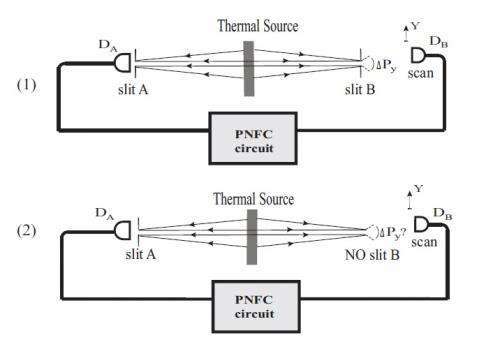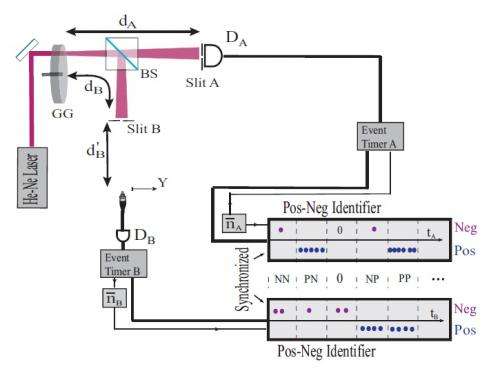Illustration of Popper’s experiment realized with randomly paired photons in a thermal state. In the second set-up, there is no “slit B” for the photon on the right. The new results show that this photon is not affected by a measurement on the left photon (which does travel through a slit), in agreement with Popper’s prediction. Credit: Tao Peng, et al. ©2015 EPLA
(Phys.org)—Like Einstein, the philosopher Karl Popper was a realist who was deeply bothered by some of the odd implications of quantum mechanics. Both Popper and Einstein disliked the idea in Heisenberg's uncertainty principle, for instance, that precisely measuring one property of a particle means that the particle's conjugate property is completely undetermined. This idea undermines the basic principle of common-sense realism: that every particle's properties must have precise pre-existing values, which do not depend on being measured.
Both Popper and Einstein proposed thought experiments critiquing the uncertainty principle. But while Einstein, Podolsky, and Rosen's EPR experiment is quite famous, Popper's experiment is not as widely known.
Popper first published his proposed experiment in 1934, and in 1999, physicists Yoon-Ho Kim and Yanhua Shih realized Popper's experiment for the first time. In what came as a surprise to many, their results agreed with Popper's predictions, yet are not generally considered to be a true violation of the uncertainty principle, as Popper believed. The findings ignited a great deal of critique, both of Popper's original ideas and how they might be realized and interpreted.
Now in a new study published in EPL, Shih and coauthors at the University of Maryland in Baltimore and Oakland Community College in Waterford, Michigan, have again realized Popper's experiment using a different approach. Once again, their results agree with Popper's predictions, yet still do not violate the uncertainty principle. However, the researchers explain that the results do reveal a concern about nonlocal interference, as the observations suggest that a pair of particles is instantaneously interfering with itself, even across large distances.
Tale of two particles
The uncertainty principle places a fundamental limit on the precision with which conjugate pairs of physical properties of a particle, such as position and momentum, can be determined simultaneously. Mathematically, this means ΔpyΔy ≥ h, where p and y are the momentum and position of a particle, and h (Planck's constant) is the minimum amount of uncertainty required.
In his thought experiment, Popper considered what the uncertainty principle might mean for a pair of particles that are entangled, meaning the particles have both position-position correlation and momentum-momentum correlation with one another. The EPR thought experiment, published in 1935, similarly considered the case of an entangled pair of particles.
Theoretically, if the position or momentum of one entangled particle is measured, then this knowledge can be used to instantly determine the position or momentum of the second particle—and with exact certainty, since the particles' properties are inherently correlated.
Popper wondered what would happen if the position of one of the entangled particles were restricted within a narrow slit, Δy. Even if no slit were placed in the way of the second particle, the position of the second particle would also be restricted within the narrow range of Δy, due to the position-position correlation between the two particles. In this case, would the second particle be "diffracted" by a nonexistent "slit" in order to preserve ΔpyΔy ≥ h?
Popper believed no, that the diffraction of the second particle would happen only in the case of a real slit, and not by a nonexistent "slit." He predicted that, without the use of a real slit, the second particle should not be diffracted at all. However, this prediction means that the second particle's position has a precise value, so that ΔpyΔy < h. Popper considered this result a violation of the uncertainty principle, as it seems to show that the uncertainty is less than the minimum requirement.
Illustration of the new experimental set-up used to realize Popper’s experiment. One entangled photon travels through slit A, while the other travels a different path through slit B, which can be adjusted to be the same width as slit A or wide open. Credit: Tao Peng, et al. ©2015 EPLA
"Perhaps, deep in his mind, Popper could never accept the idea that the measurement of the position of particle one can simultaneously affect the position of particle two," Shih told Phys.org.
Ghost imaging experiments
Popper's experiment can be realized in a couple different ways. Kim and Shih's 1999 experiment was performed using entangled photon pairs generated by a spontaneous parametric down-conversion (SPDC) source, which is commonly used to generate entangled particles.
In that experiment, Kim and Shih first confirmed that the entangled photon pair can achieve a position-position correlation by means of a technique called ghost imaging. In ghost imaging, the two entangled particles can "image" a real slit from the path of photon one onto the path of photon two at a distance, creating a so-called "ghost slit" for photon two. While photon one is restricted within the real slit, photon two must also be instantly restricted within the ghost slit.
Kim and Shih then compared their measured diffraction pattern from the ghost slit with the diffraction pattern of a real slit in place of the ghost slit. It was a surprise to everyone, including Kim and Shih, that their experiment agreed with Popper's prediction: the diffraction pattern from the ghost slit was much narrower than that of the real slit. Just as Popper had predicted, particle two was not affected by a measurement made on particle one.
In the new paper, Shih and his coauthors observed the same results, but instead of using entangled photon pairs, they used randomly paired photons in a thermal state. Using similar ghost imaging technology, the physicists confirmed that the randomly paired photons in the thermal state are able to produce a ghost slit at a distance. They then compared their measured diffraction pattern from the ghost slit with the diffraction pattern from a real slit in place of the ghost slit. It was a surprise again to find that the new experimental results agree with Popper's prediction.
The important difference with the second experiment is that the randomly paired photons do not have any pre-prepared entanglement, which means they are considered to be a classical system. This raises the question, how could a classical system produce the same result as a quantum system? Shih is confident that they will soon find an answer.
Uncertainty preserved, nonlocality in question
Although it may seem like the above two experiments violate the uncertainty principle because the results show a smaller-than-required degree of uncertainty, Shih and his coauthors explain that no violation has occurred due to the fact that the experiments involve photon pairs rather than individual photons. The scientists argue that Popper's original thought experiment was based on a misunderstanding of the proper context of the uncertainty principle: it governs the behavior of single particles only, not the "correlation" of two particles.
In a sense, the entire thought experiment is flawed, at least in terms of what it means for the uncertainty principle. However, the researchers think that Popper's (and EPR's) concern about the nonlocal correlation of distant particles is still reasonable and fundamentally sound.
As the researchers explain, the results of Popper's experiment still reveal some important insight because the observations suggest that the photon pair is interfering with itself instantaneously in a phenomenon called nonlocal interference. In the new experiment, the randomly paired photons have two different yet indistinguishable probabilities to be simultaneously annihilated at two distant photodetectors. The observations are the result of the superposition of these two probability amplitudes. In this sense, the physicists explain that the same question that faced Popper and Einstein is still facing physicists today, which is, how long does it take for nonlocal interference to occur?
"Assuming the two random photons are separated by one light-year, how long does it take to force particle two to appear at a certain position after observing the first particle?" Shih said. "In the view of quantum mechanics—specifically, the theory of two-photon interference—a precise measurement of the position of a particle would instantly determine the position of its entangled twin at a distance. As a believer of realism and relativity, Popper had to ask these questions, similar to Einstein, Podolsky, and Rosen."
In addition to the analysis in this latest paper, there have been a wide variety of other criticisms of Popper's experiment over the past few decades. Although Popper's experiment may not have been the perfect way to test the uncertainty principle, it has nevertheless succeeded in opening new perspectives on a model of the world that may never be completely understood.
More information: Tao Peng, et al. "Popper's experiment with randomly paired photons in thermal state." EPL. DOI: 10.1209/0295-5075/109/14003
Yoon-Ho Kim and Yanhua Shih. "Experimental Realization of Popper's Experiment: Violation of the Uncertainty Principle?" Found. Phys., 29 (1999) 1849 http://link.springer.com/article/10.1023%2FA%3A1018890316979
Journal information: Europhysics Letters (EPL)
© 2015 Phys.org






















